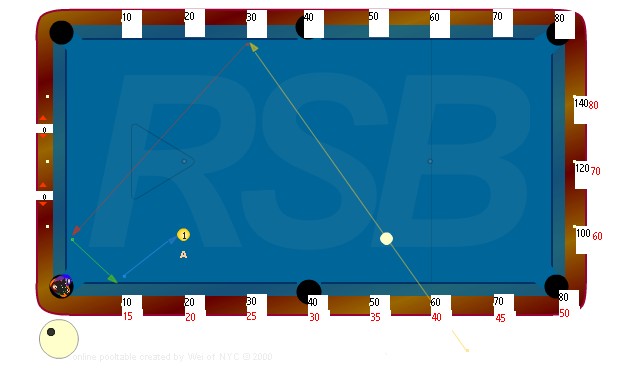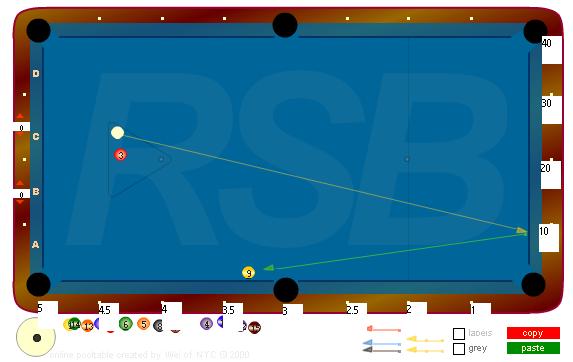Diamond System In Snooker?
8/24/2006 9:04:30 PM
Diamond System In Snooker?
Is there anyone out there playing snooker who uses the "diamond system" in regular pocket billiards?
If so, what are the specifics of your diamond systems?
Diamond System In Snooker?
Replies & Comments
 jana on 10/13/2006 6:53:29 PM
jana on 10/13/2006 6:53:29 PMI'm not sure about this one. I think snooker tables have the diamonds, but since the table is generally much bigger than a regular pocket billiards table, they diamond system may be more difficult.
kyle on 12/23/2006 2:00:20 AM
The systems would be the same for any size table because the diamonds are equal in relation. They can be used to get out of a hook in pool or snooker but more commonly used in billiards, depending on what system you're using (multiple different ones for 1,2,or 3 rails,) you create a formula from where each ball is (the cue ball and the ball you're kicking at)too find your spot on the first rail you hit.
kyle on 1/19/2007 9:37:54 PM

- Black numbers are object ball numbers / first rail numbers
- Red numbers are cue ball numbers
- All calculations are made at the edge of the cushion not the diamond itself.
For a 3 rail kick the formula is OB#(object ball#)+ First rail# = QB# (cue ball#)
- Find your object ball #, in this case the one ball is at about diamond # 20 (black #) it's also about the width of a diamond off the rail {subtract this distance(10 for each diamond width)from the original 20 to get your OB#=10}
- Hold your cue over the cue ball while pointing at the first rail (top rail in picture)find the 1st rail # (balck#) that when added to your OB# (10) equals your red QB# (which extends straight back in line with your cue). The exsample the fist rail # is 30, the QB# is at 40 (it's more like 38 in picture because you get your # from where this line extends back and crosses the edge of the cushion, but we'll say 40) so OB#(10)+1st rail#(30)=QB#(40ish).
- Tables all play alittle different most cases you want some running gear in this case a bit of left side.
For a two rail kick the formula is QB# - OB# = 1st rail number
- In the same exsample the one ball is at diamond 20 and a diamond width off the rail.Unlike the three rail kick the distance from the cushion (10)is added rather than subtracted, so your OB# for a 2 railer would be 30.
- In the top exsample you would be kicking at around 12 (top black#'s) with your QB# extending back to 42 (red #'s).
Uour equation for 2 rails in this exsample would be QB#(42)-OB#(30) = 1st rail number(12)
Hope this isn't too confusing.
kyle on 1/19/2007 10:10:07 PM

This next system is for long one rail kicks when your object ball is on the long rail.
- The nine ball is just before diamond 3.5 (around 3.4)
- The cue ball lies more than 3 diamonds past x(which would be the bottom left corner)
- Take your OB#(3.4) and multiply it by 3 (because cue ball lies past C three diamonds from the pocket. 3.4x3=10.2
- Your aiming point on the short rail would be around 10.2.
- If your cue ball was between diamonds B and C you would multiply by 2. If past diamond D multiply 3, 4, by 4, etc.
acuerate on 1/31/2010 7:57:55 AM
This is a very interesting topic. As far as I know (I ll check with my business partner Chris Henry - coach of Stephen Hendry, Ebdon, etc... ) if he ever came across a snooker playing using the 'diamond system' ... Obviously it's quite a challenge if there are no diamonds visible on the table ... ;-) If anybody is aware of this system being used by snooker players, then I m happy to hear about it!
Enjoy your Game,
Johan Acuerate Team
1pocketmike on 12/11/2011 7:14:05 PM
the diamonds on the head end of the table are not equadistance. Can anyone explain why the diamonds are offset on just this end?
Mitch Alsup on 12/13/2011 1:44:54 PM
Diamond Systems were invented on 10 foot Carom (non-pocket billiards) tables as an aid to aiming. The diamonds are placed equidistant from each other and from the point of reflection on the cushion. This means that a corner has two diamonds one for the end rail and one for the side rail and neither diamond is in the center of the corner pocket (and neither is marked).
The diamonds are placed into the rails (3+11/16) such that a 3-rail shot from corner to corner will use the natural roll of the CB. The natural roll of the CB causes the CB to arc gently forward after each rail contact as the natural roll changes direction.
If you work out the "math" for this kind of physics problem, you will find that tables invariable "get shorter" as table size decreases. So on a 10 foot table corner to 3-rd diamond is square to the table and hits, on a 9 foot table, you need to go long by about 1/5 diamond (cloth and rail composition dependent), on an 8 foot table about 1/3 diamond. Tables with faster cloth will play more square than tables with slower cloth. Tables with dirty balls will play less square to the diamond system. Temperature and humidity also affect tables speeds and rail bounce patterns.
Diamonds are useful in lining up one rail kicks and banks, just remember the OB reflects 1/2 ball away from the rail. Here the marks are merely equidistant and used for helping you compute where to aim and then aim there.
Diamonds are NOT useful in lining up 2 rail kicks because the easy method is to place the tip of your cue at the point equidistant from the CB and the desired OB, then rotath the butt of the cue until it points directly at the center of the adjacent pocket. Translate this angle from the center to the CB and you have your direction for a 2-rail kick. (no diamonds needed) For these shots you MUST practice english control to make the system play true, mostly follow english with just a touch of running english is required--alternately you can shoot the CB true and compensate with slightly less angle towards the chosen reflection pocket. For extreme cases, one can shoot outside the given line and use "kill" english to get around other interfering balls.
As to snooker--I know nothing.
tasha_silvester on 1/2/2013 10:50:26 PM
A big thanks to all the participants of this forum. Billiard table diamond system concepts were very confusing for me from day one and I have learned several new things here. I am looking forward to some more posts.
user1608326780 on 12/18/2020 1:26:21 PM
I have a 5x10 snooker table with just a few dots.
I anguished over the locations. These were on long rails at 25" and 28". Even though 28" is the correct spot for this size table this was in fact a marker for a billiard baulk line and the opposite end dots at 25" are for a snooker baulk line.
Using the same rail distance as these dots, the simple math tells us it should be a 14" spacing. Eventually it dawned on me that these locations ONLY WORKED FOR SNOOKER as these are smaller diameter.
I had determined on my own (same as in an earlier post) that this could be compensated for billiards by adding 1/5 diamond spacer PER diamond used.
If the object ball rail was 2 diamonds then 2/5ths added. 4 diamonds the 4/5ths and so on. Otherwise the shots were always long.
Interestingly though these locations still work for very hard shots as that closes the angle. However the simplest solution I found was to close the angle by placing a 2nd row of billiard diamonds about 1.25" behind the snooker diamonds. For me it was all the way to the outside edge with a nickel sized dot. I actually glued dimes on as my snooker dots.
Now I use the inside lines for snooker and outside for billiards with no changes to my routine. Confirm the dot locations by hitting several banks shots for accuracy.
I really hope this saves some from my frustrations.
Diamond System In Snooker?
- Title: Diamond System In Snooker?
- Author: cue-shot
- Published: 8/24/2006 9:04:30 PM
